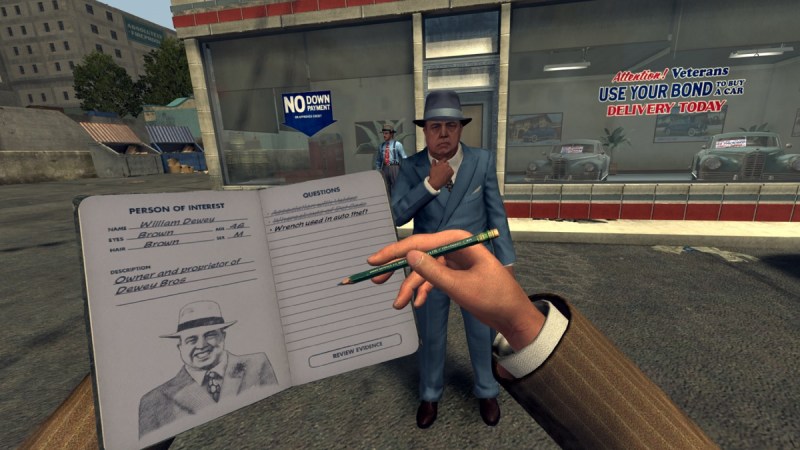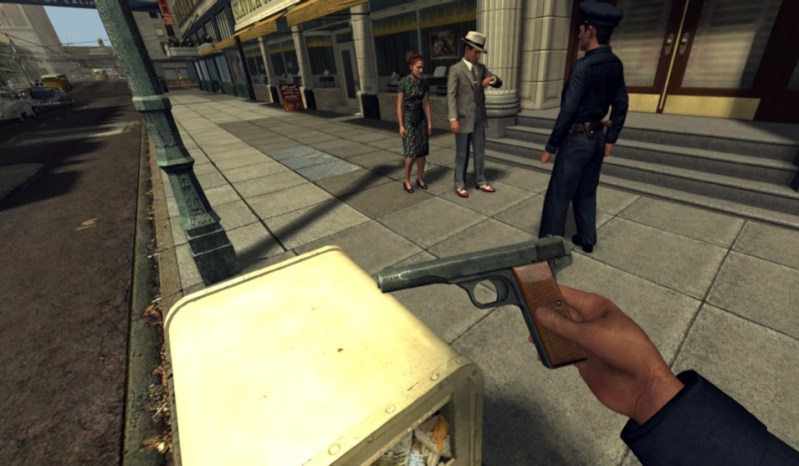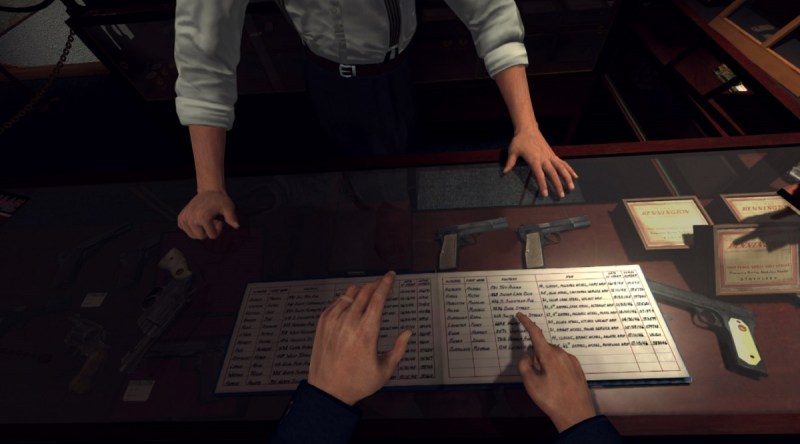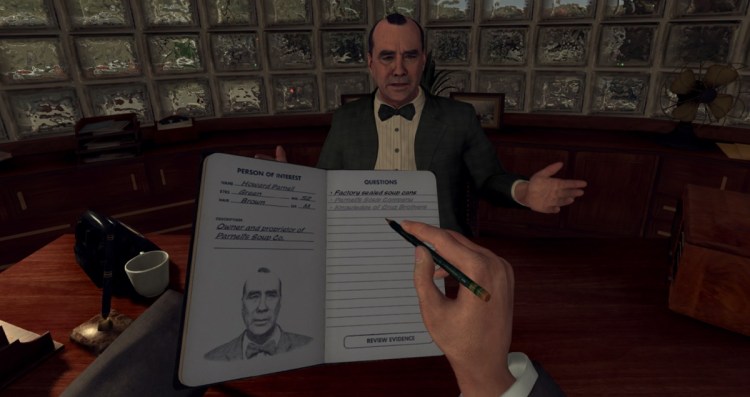Rockstar Games is hoping for a revival for one of its classics, L.A. Noire, a 2011 detective game that it’s relaunching on the PlayStation 4, Xbox One, Nintendo Switch and the HTC Vive virtual reality headset.
I had a look at it on the Switch and the HTC Vive, and it brought back some good memories and created new headaches. I’ll talk more about that in a bit. But it was both a good and a bad experience to try two very different ways of experiencing the crime game.
L.A. Noire debuts on the consoles on November 14, and it will debut as a more limited set of seven cases on the HTC Vive in December. The full game will sell for $40 on the PlayStation 4 and the Xbox One, and it will sell for $50 on the Switch. It will debut for $30 on the HTC Vive. It’s a mature-rated game that puts you in the shoes of detective Cole Phelps, a war hero who joins the Los Angeles Police Department as a cop during the violent 1940s. The basic activities in the game include investigation, interrogation, and action (like fighting or driving).

Above: In VR, you can point your pen at something by using your hand as if you were holding a pen.
The thriller brings alive the glitz, glamour, and corruption of the 1940s. Phelps investigates cases that are based on real world crimes. It takes a very cinematic approach, and it pioneered the use of MotionScan, a tech that captures and scans an actor’s facial performance. It helps a player read the fine details of a witness’s face as they are responding to an interrogation.
This port has a big difference compared to the original game, where you (playing as Phelps) had to decide what a witness was telling you and how you were going to respond. In the 2011 game, you had to classify a witness’s comment as either truth, doubt, or lie. Now, as the detective, you read the performance and decided whether to play the good cop, bad cop, or an “accuse” response that challenges the character’s testimony directly.
I had to make notes using a pencil in the game, which meant that I had to use my fingers on the touch control to check off something in the notepad. It was an example of how VR can mimic physical actions in a way that is very different from the way that you use a game controller. It works faster than relearning how to do something in VR, but only because I’ve become so accustomed to using a game controller. To those who don’t play games, the VR controls might prove to be more intuitive because, again, you are mimicking physical activity. When you want to look at an object from multiple angles, you pick it up with your hands and turn it around.
The experience on the HTC Vive

Above: The office in L.A. Noire.
We started out the VR experience on the HTC Vive in Phelps’ office. I could go around the room, pick up objects, play with a gun, and try on hats. When I looked at myself in the mirror, my whole outfit would change when I tried on a different hat. I also tried to put on a record on the record player (something that a kid today probably wouldn’t know how to do). But I failed at that task a few times before I got it right. In VR, there’s no such thing as fine motor skills. Still, at least everything in the office was interactive, which added a sense of realism to the experience. Outside, the graphics had better touches, like better lighting than the original.
Then I tried to solve a couple of cases. I had to dig up some information from witnesses, interrogate suspects, and make an arrest. Some of it was a typical video game interaction. I had to push a button to run. But in other cases, I had to use my hand controls and gestures to accomplish tasks in the virtual environment. I could also get my character to move forward in a walk by interacting with the touchpad.
During one interrogation, I had to look at a woman’s face to see if she was lying. She had a shifty look and wouldn’t look me in the eye. I also found a receipt for a gift that connected her with a suspect. So I played the Bad Cop choice, and Phelps yelled at her. That prompted her to become more honest and fess up some information that led me to the suspect.

Above: You use your fists in the VR version of L.A. Noire.
Sometimes the suspects just ran. I had to press the right button on my touch control in order to run after the guy and catch up with him. If I messed that interaction up, he would have been able to escape. I managed to do alright on that front the first couple of times that suspects ran away from me. Then, when I chased them for a while and caught up with them, I had to fight with the suspect to collar him and call in help.
The fist fight scenes with suspects exposed both the highs and lows of VR. The fighting with my actual balled fists felt real, as I had to really swing in a physical way to try to connect with the opposing fighter. This was one of the ways that L.A. Noire in VR was far different from the experience of the game with a traditional controller. It was more visceral, in a way that leaves you short of breath when it’s over.
I get what the developers were trying to get at. But in some ways, Rockstar shows that even it can’t overcome the drawbacks of virtual reality, as enabled on the HTC Vive. When I had to punch my opponent in a fist fight, I had no idea exactly how far away the opponent was. To get a sense for this, I had to take a swing — a physical punch — at the air. I was a little paranoid about doing this because I was afraid I was going to wind up punching a wall or getting tangled in a cord.
Anyway, about half the time, I missed. My swing fell short of reaching the opponent. This was because I had no real way of telling exactly how far away that opponent was, as perceived by the game. So I took a couple of steps forward and I threw another punch. This time I hit the opponent. Once I had found the range, I could hit the guy with reasonable accuracy. I also had to put my arm up to block his punches or step back to evade. I did so. But sometimes that was successful and sometimes it wasn’t. Sometimes, I would raise my hand to block, and the guy would hit me anyway. In any case, I wasn’t satisfied with the accuracy of punching and moving in VR. Whenever I connected with the suspect, I let out a noise like a yelp. Usually, I’m just silent when I’m pounding someone else in a video game.
This part isn’t Rockstar’s fault. Rather, it is a limitation of the current VR systems. But the good thing was that I was really tired after I finished the case. I was so sweaty I had to take off my sweat shirt and drink some water. That’s one of the good things about VR. It gets you off the couch and makes you exercise. Very kinetic.
I managed to win the fist fights. Despite the interaction problems of VR, it worked good enough.
Other tasks proved easier to execute in VR. I had to go to a garbage can and pick up a gun from it. That was easy.

Above: Picking up a pistol with your hand is easy in VR in L.A. Noire.
But It turned out that driving was even tougher than fighting. The demo folks asked me if I wanted to drive while standing or sitting. I chose to sit, so they brought a chair behind me and I had to sit down without actually seeing the chair. Then I had to use my hands, but not my feet, to try to drive. I turned the key with my fingers. That turned out to be something I had to try a couple of times to get it right.
I had to put my hands on the wheel. I had to reach out and pull the grip button on the side of the Vive controller. I did this with both hands to get both hands on the wheel. The left trigger was for hitting the brake or reversing. The right trigger was for accelerating. When I wasn’t doing anything, the car just drove forward at a pretty fast clip. I tried turning and I had to really use my hands because the old cars didn’t have power steering. Inevitably, I crashed. Once again, I found that driving with a game controller was far easier than driving in VR, which in turn was far harder than driving in real life. Fortunately, you can always ask your partner to drive the car for you in the VR game.
All told, there are seven case experiences available on the HTC Vive version of L.A. Noire. It’s not the full game, as the cases were picked for their suitability for VR. In conclusion, while the VR interaction shows promise and is interesting, I don’t think it’s a superior way to play a video game that was perfectly fine for me in the good old days with a simple video game controller.
The experience on the Nintendo Switch

Above: Looking through some evidence in L.A. Noire.
Rockstar’s folks showed me one scene on the Switch as well. The game looked nice in 1080p on a big screen.
We started playing The Lipstick Murder. It turned out it was one of the scenes I really hated in the original game. It wasn’t because it wasn’t well done. It was because it was too much. In this case, Phelps is promoted to detective and he and his new partner drive out to a crime scene in a park. I wanted to drive, but then my partner didn’t actually let me. When we show up at the crime scene, the police have roped off an area.
In the middle of it was the body of a naked woman. She wasn’t partially revealed. She was entirely nude, from her face to her pubic area to her feet. And she was stained with blood, bruises, and had crude words written in lipstick on her body. I remembered this grisly scene and always thought it just showed too much. For sure, police have to deal with this in real life. But I really don’t like seeing things so graphic in a video game. It reminded me that the game was rated M for mature.
I had to stand over the body of the woman and lift up her arms to look at for clues. I had to turn her head from side to side. I could do some of this pushing the joysticks and the buttons. On the big screen TV, the imagery looked great and the controller functioned just like any other controller. But when I disconnected it from the TV, I could use the Switch’s touchscreen to do some tasks. I could drag a finger across a screen to do something, like swiping my finger to turn a page in a notebook. But I had to return to the stick and button controls for other tasks. I could tap to go to a place on the screen. But that wasn’t an improvement on the controller.
For the most part, playing on the Switch was just as good as playing with any other console. I had to move the victim’s head from side to side, and ask the other officers what weapon might have caused the wounds on her head. Ick.
It occurred to me that this game’s presence on the Nintendo Switch is kind of a departure for Nintendo, which is often associated with family friendly games. I drove around in the car and found that I still ran over people in the street, but it was easier than driving in VR. I was supposed to feel the Joy-Con’s HD Rumble in certain places, but I didn’t notice it working.
Given the choice, I would probably favor playing the game on the Switch instead of the HTC Vive. And I’d also probably prefer playing it on the Xbox One or the PlayStation 4, but I haven’t seen those versions yet. I applaud Rockstar for trying, but it is in a tough spot. VR isn’t truly ready yet to make a VR version of a game into a better experience than a traditional console version of a game, at least in this case. But overall, L.A. Noire is a fascinating game, and those who missed it in 2011 should probably give it a spin in its new and improved form on the consoles.

